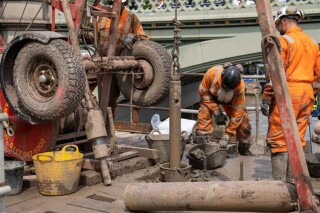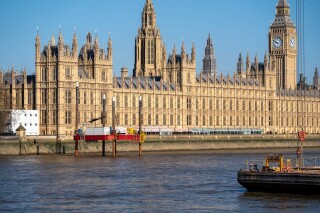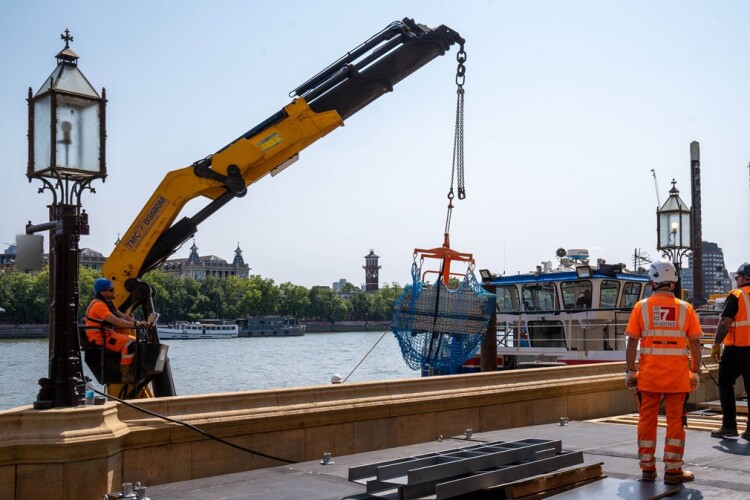This post was originally published on this site
https://www.theconstructionindex.co.uk/assets/news_articles/2025/10/1761115703_restoration-and-renewal-delivery-authority-ltd-3.jpgBetween April and September 2025, two boreholes were drilled on Parliament’s River Terrace and a further 14 boreholes were drilled to depths of up to 74.5 metres in the River Thames to map geological conditions.
Using a jack-up barge, positioned opposite the Palace’s river-facing terrace, engineering teams drilled 14 boreholes into the Thames riverbed to assess its geological makeup. These marine surveys focused on capturing a detailed snapshot of the riverbed’s condition, providing essential data to support potential future construction near the river frontage and any temporary works within the Thames.
This was the first time river access has been used to deliver equipment to the Palace of Westminster for the Houses of Parliament Restoration & Renewal Programme.
Discoveries include remains of the 19th century cofferdam, designed by architect of the neo-gothic palace, Charles Barry.
The River Thames works were delivered by ground investigation specialist Structural Soils, part of the RSK Group, under the direction of the Palace of Westminster Restoration & Renewal Delivery Authority.
Gareth Jones, Structural Soils’ senior engineering project manager, said: “Our team applied specialist expertise in overwater drilling under tidal conditions, using boreholes, cone penetrometer tests, and geophysical surveys to assess site geology and hydrogeology. Advanced CHIRP modelling also enabled us to create a 3D model of the superficial soils. These works were undertaken from both a central moonpool and from a cantilever that provided a stable, over-the-edge platform from which we could safely work close to these historic structures.”
Data from this series of surveys will inform future designs including options for basement use and for service routes.
On land, boreholes drilled on the River Terrace sought to confirm the boundary between two major geological layers: the London Clay Formation and the deeper Lambeth Group. London Clay is widely used for tunnelling due to its stability, while the Lambeth Group presents more challenging ground conditions, including high water pressures.


The River Terrace installations include two types of monitoring equipment. Groundwater monitoring devices have been installed to track changes in water quality and conditions over time, providing essential data on tidal fluctuations that will inform the design of future basement structures. In addition, due to the proximity of the boreholes to the Palace, vibration monitoring devices were deployed to assess any potential impact on the building. This data will help predict how the structure will respond to the planned building works involved in the refurbishment.
The River Terrace surveys, carried out by site engineering specialist Concept, also marked a shift in logistics management on the Restoration & Renewal Programme. With limited land access to the Palace of Westminster’s River Terrace – due to traffic, safety and heritage considerations – the project team used the Thames to deliver heavy drilling equipment directly to site.

Andy Piper, design and engineering director at the Restoration & Renewal Programme Delivery Authority, said: “These investigations have given us invaluable insight into the geological conditions east of Parliament, an area that has never been mapped in such detail before. Alongside critical data to inform design, we confirmed the location of Charles Barry’s 19th-century cofferdam, a fascinating glimpse into the engineering behind the rebuilding of the palace following the fire of 1834.”
These latest investigations build on seventeen previous borehole surveys across the Parliamentary Estate, adding data to support the Delivery Authority’s digital modelling of the Palace.
While lab testing of borehole samples continues, early findings from the River Thames deposits have offered clues about how Charles Barry’s cofferdam was dismantled. A buried timber pile found just below the riverbed suggests the structure was cut down rather than fully removed – echoing an 1849 article that described the difficulty of extracting timber piles from the river.
Most recent cost estimates for the various options under consideration for the restoration and renewal of the Palace of Westminster range from £7bn to £22bn. Updated estimates, detailing delivery options, timescales, risks and benefits, are expected to be published later this year.
Got a story? Email [email protected]


